by Steve Cunningham
I continue to be amazed at the number of inexpensive condenser microphones on the market. In the mid-1990s you had to spend big bucks to get a good-sounding large diaphragm condenser for voiceover work, as prices for a quality condenser started at $1200 and went up sharply from there. Many of us ended up with dynamics like the RE-20 and -27 to get a big, detailed sound. I’m not knocking dynamics mind you, but the fact is, there’s no way for a dynamic microphone to reproduce transients and high frequencies as well as can a condenser. The combined mass of a dynamic’s mylar diaphragm and attached voice coil just can’t move as quickly as can the 3 mil diaphragm in a condenser.
That’s just the raw physics of the thing.
The fact is that today there is a dizzying array of condenser microphones priced under $300, many of which are great for voice work.
At the recent NAMM Show in Anaheim, I happened to spend a few moments at the AKG booth where I noticed that they’d upgraded their entire Perception line of condenser microphones. According to the company, these mics are designed and engineered in Vienna, and built in China under close supervision and subject to rigorous quality control. I’m a fan of AKG microphones in general, so I had them send me one each of the three large diaphragm condensers in the Perception series. Let’s take a look at a trio from AKG. Do I need to mention that they all require 48V phantom power? I thought not...
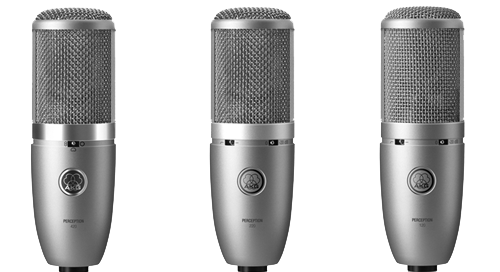
THE DISCLAIMERS
I’ve said this before and I’ll say it again -- buying a microphone is a lot like buying new underwear. It’s a very personal decision, and while I’m happy to provide some guidance here, this is not a decision you want to make on the basis of this or any other article you’ve read recently. When considering a microphone, borrow one, rent one, or whatever else you have to do to get one you can try out, preferably in your studio with your audio chain.
If all else fails, find a dealer with a reasonably quiet listening room and audition them in that environment. What you don’t want is to try to evaluate your voice on a microphone while some knucklehead is wailing out “Smoke On the Water” in the background. If you’re considering among multiple candidates, try to set them all up once so that you can perform a reasonable A/B comparison in real time.
Remember that our memory for sound, especially in terms of frequency response and overall quality, is fleeting.
It’s also important to note that while the quality of Chinese made microphones has improved markedly over the years, as evidenced by these AKG offerings, the old maxim of “you get what you pay for” still applies. Few pro-engineers will mistake these microphones for a true German built AKG or Neumann. So as good as these mics are, please keep in mind that if you want the real sound of a Neumann, you’re going to have to pay for a Neumann.
While these mics represent excellent value for the money, it’s still true that you get what you pay for. Many of these microphones are manufactured in China, and while they may claim to use the same capsule design as a German mic costing ten times as much, few pro engineers will mistake them for the real thing. A couple of models are also inconsistent from unit to unit, so it pays to audition more than one of them. Now, none of this implies that we’re comparing apples and oranges, because these mics are surprisingly good. But if you want the sound of a Neumann, you’re gonna have to pay for a Neumann.
THE PERCEPTION 120
With a retail price of $230 and a street price of about $120, the perception 120 is the least expensive of the three new models. It’s a side-address large diaphragm condenser with a fixed cardioid polar pattern, and claims a 20 Hz to 20 kHz frequency response. Its zinc alloy body and grill have a metallic blue tint to them, and it ships in a padded cardboard box with no shock mount, although it does include a stand adapter. According to the specs, it has a sensitivity of 22mV/Pa and a maximum SPL of 150dB with the pad switched in, so it’s unlikely you can give it anything in the volume department that it can’t handle. In addition to that -20dB pad switch, the 120 also has a low-cut filter (300 Hz, -12dB per octave), which works well to eliminate proximity effect.

The Perception 120 replaces the now discontinued Perception 100. The primary difference between the two of them is that the 100 used a one-inch (25 mm) capsule, while the 120 uses a capsule that measures two thirds of an inch (17 mm). As a result, the low-end response drops off sooner but the frequency plots of both models are quite close down to 150 Hz, and as we know there’s very little useful voice information down there anyway. In addition, the sensitivity of the 120 is slightly higher, although so is the self-noise (it’s 22dB-A for the 120 versus 16dB-A for the 100).
The 120 reminds me somewhat of the slightly less costly Audio Technica AT-2020 that I recommended for my sub-$500 voiceover kit (see the July 2007 issue of RAP). Overall it sounds fairly flat and perhaps a little compressed. It has a high-end that is clean with a bump near 10 kHz for a bit of detail and, on women, for a bit more presence. The self-noise is higher than I would like, although I don’t think that’s a problem for most close-miked voiceover applications. The 120 is sensitive to plosives however, so you’ll want to keep a quality pop filter handy, and plan on buying a shock mount as well. Given all that, it sounds good for both male and female voice talent, and would seem to be an excellent VO mike for voiceover newbies on a budget.
THE PERCEPTION 220
Spend a few bucks more and you can step up to the Perception 220. With retail price of $350 and a street price well below $200, you may find it worthwhile. For openers, the side-address 220 has a fixed cardioid capsule with a full one-inch diaphragm. More importantly, its self-noise drops to a respectable 16dB-A, although its output ensitivity drops to 18mV/Pa compared to the 120. The zinc alloy body looks identical to the 120, save that the grill is now nickel-colored instead of blue, and instead of a padded cardboard box you get a real aluminum carrying case. Also included is a proper spider shock mount, an essential addition to any of these microphones.
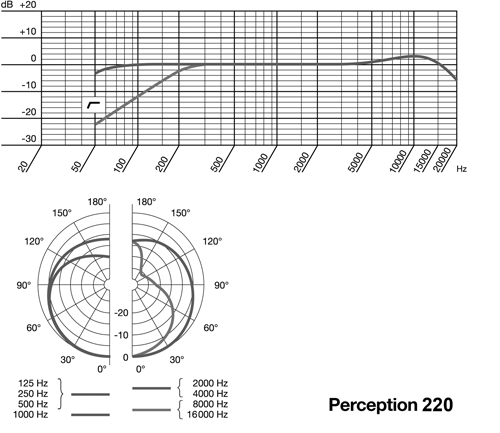
The frequency plot of the 220 shows that it has the same presence bump around 10 kHz, as does its less expensive sibling. However, that same plot also shows a much extended low-end in the 220, doubtless due to the larger capsule size. The 220 includes the same -20dB pad switch and the same low-cut filter switch (again, 300 Hz, -12dB per octave) as does the 120.
In use, the Perception 220 does sound different than the 120, especially in the low-end and the low mids. This is to be expected, given the larger capsule size. I also noticed a slight difference in the top end, which was slightly smoother and seemed more extended than the 120, although it was equally open sounding. Both of these microphones are solid-state, but I have no way of knowing whether the electronics in them are identical or not so I can’t say what difference they might make.
So what you do you get for your extra $75 to $100? As far as I’m concerned, the biggest bonus is the reduced self-noise. The extended low end is a fine thing, although it is not of great use with most male voice talent. On the other hand, you do get a necessary shock mount and a real big-boy carrying case in which to store the thing.
The build quality of this microphone is above average among Chinese-made microphones at this price point, and it both looks and feels like a substantial, pro piece. Finally, I guess I just like the sound a little bit better -- it seemed less compressed and more natural. It’s still affordable enough to be considered appropriate for a newbie, but it would also serve more experienced talent as a good step up from a dynamic mic.
THE PERCEPTION 420
With a street price under $300, the Perception 420 replaces the discontinued Perception 400 and is a dual-diaphragm, switchable-pattern, side-address mic that’s intended as a multi-application studio workhorse. It is supplied with a substantial shock mount in an aluminum case, and employs a pair of back-to-back, one-inch capsules, and offers omni, cardioid and figure-8 polar patterns, selectable via a small toggle switch in the same cast zinc-alloy body as the other models. There is also a switchable -20dB pad, along with that low-cut filter switch (300Hz, 12dB per octave), so taken in total there are a lot of features here for surprisingly little money. Other than the blue metallic finish, the Perception 420 looks like what a side-address studio mic should look like, and the general standard of engineering and finish is excellent.
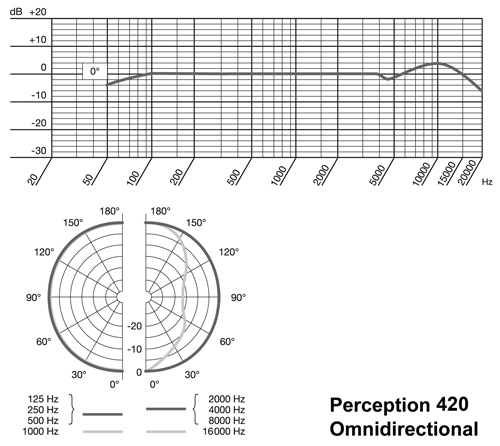
With the pad switched in, the 420 can handle SPLs up to 155dB, and the frequency range is quoted simply as 20 Hz to 20 kHz. But the frequency response curve reproduced here shows a reasonably flat response for all three patterns, although the shape and position of the modest presence peak differs for each of the patterns. Its sensitivity is 28mV/Pa (-31dBV) with an A-weighted signal-to-noise ratio of 78dB, so its performance seems comparable with other well-designed mics of a similar type at this price point. Overall, the mic measures 53 x 165 mm and weighs 525g (18.5 ounces), giving it a substantial feel without making it so heavy as to cause the mic stand to sag.
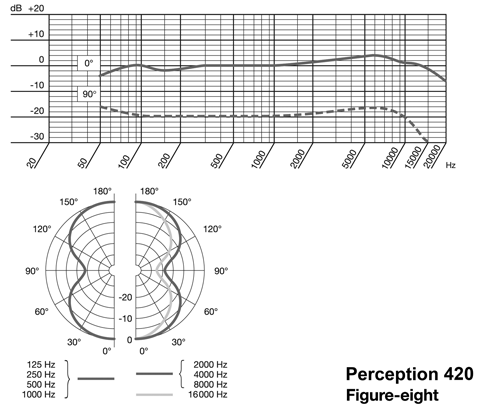
Although the marketing materials tend to promote the 420 as an all-around instrument microphone, there’s no reason not to use the 420 for voiceovers. Its sound is neutral compared to others — most dedicated vocal mics will have a more pronounced presence peak. The mic’s resistance to popping is better than average, although a pop shield should always be used when recording vocals, and the general tonal character remains reasonably consistent between the three patterns. There’s an audible switching click that occurs when you change patterns, but the circuitry settles down quickly after that.
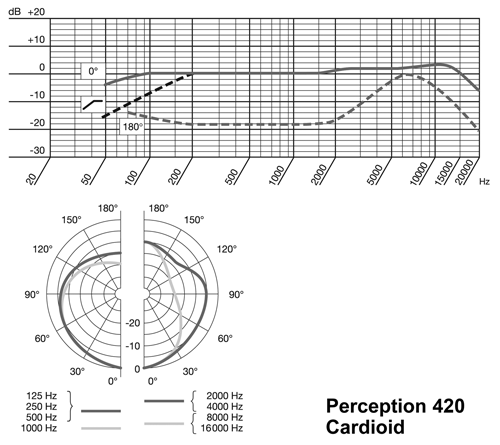
The cardioid pattern is about what one would expect and, as the frequency plots show, exhibits the flattest frequency response. The omni pattern has a significant bump in the high end, while the figure-8 has the most irregular plot of the three. Further, the figure-8 has less side rejection than other multi-pattern mics I’ve used, and much less than a ribbon, so the conscientious engineer should take this into account. But I usually use switchable polar patterns as a crude form of EQ, and in this way the 420 gave me some different colors to work with.
DON’T WRAP THAT ONE UP, I’LL EAT IT HERE
I have to say that I enjoyed using each of these microphones, and that they all worked just fine. What I find most amazing about them is their price, and how really good they are considering how little they cost. As I said earlier, no engineer is going to mistake them for a Neumann but let’s face it, that probably makes little difference by the time the voice track has been squashed into an mp3 file.
The 120 makes a fine first microphone for voice talent, while VO actors with a few projects under their belt will appreciate the lower noise floor of the 220. The 420 is the best value in the lot as far as I’m concerned, and this one ain’t going back -- it’s staying right here. Even in this crappy economy, a bargain’s a bargain, isn’t it?
The AKG Perception 120 carries a suggested retail in the US of $229.95, while the Perception 220 rings in at $349.95. The Perception 420’s US retail price is $549.95, and all three are discounted by retailers. For more information worldwide, visit www.akg.com.

